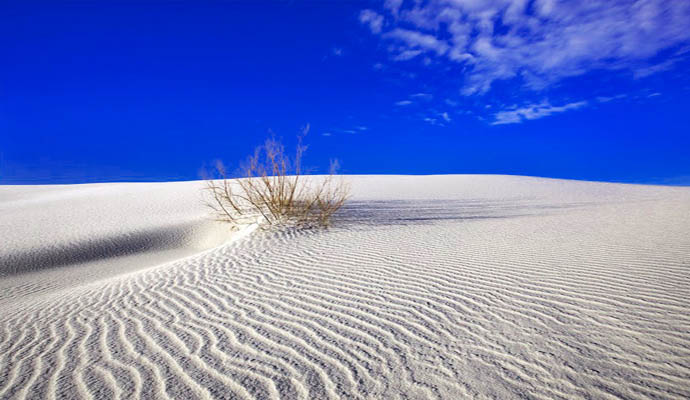
The wandering dunes of white sand gleam in sunshine as the snow plain. Whyte Sands – the fluid and changeable sand of the desert in New Mexico which are continuously filling up the stocks. On border of sand. This echinocactus violently expands on desert borders Whyte Sands where it is more moisture. Its bright red flowers effectively look against white dunes. Sculptural composition. The southwest winds dominating over the desert create surprising sculptures among white dunes from time to time. Most often their life is short-lived, but sometimes on steadier the meskitovy tree or other plant manages to grow from them. Under the scorching sun in the deserts of New Mexico white sand sparkle as soon as the dropped-out snow. These soft dunes are put not from grains of the quartz making the majority of sand of deserts, and from selenit, soft, similar to chalk, or calcium sulfate. Unlike other deserts these dunes are to the touch cool thanks to active evaporation of moisture from their surface and high extent of reflection of sunshine. The desert Whyte-Sands was stretched on the area of 700 sq.km from the mountains of Sacramento in the east to mountains San Andreas in the West. There are world’s largest superficial deposits of selenit from which receive industrial plaster. Selenit represents one of the mineral components which are most extended on Earth, but as it is easily dissolved in water, on a surface this mineral meets seldom. These unusual sandy open spaces in severe southwest territories of the USA about 100 million years ago when this area of the continent was covered by the small sea were formed. Gradually its waters receded, reserving salty lakes which also gradually evaporated under the burning sun. And except salt from the solution sated with minerals selenit was emitted, being besieged by powerful deposits where there was a seabed earlier, the Ridges of Sacramento and San Andreas began to be formed about 65 million years ago. Powerful motions of crust rumpled and vspuchivat layers of breeds together with a selenitovy substratum, uplifting them is high in the sky. Seasonal rains and thawed snow from mountains leached selenit, and the concentrated solution was washed away down hillsides, accumulating in Lyyusero’s lake. There is no exit from the lake – water can only evaporate, leaving thin layers of crystallized selenit. Then thanks to aeration these crystals otshlifovyvatsya and turn into fine grains of sand which is carried away up the pool by the southwest winds prevailing here. Sand forms the flat dunes often reaching in height of 15 m over foundation of the desert. These dunes move wind on distances to 9 m a year. As a result of infinite process of transformations the strange impression is made that all landscape in these parts leads quite independent life. Continuous movement of sand in combination with their alkaline nature and lack of rains extremely complicates life of plants. At those which manage to survive in such conditions – a yucca the poison ivy and a poplar, – were formed the long and difficult root systems which are deeply going to loose selenit. Poplar roots, for example, leave on depth to 30 m. Representatives of fauna are rare in these sand also. Among them the pale-painted earless lizards and rare night animal meshotchaty jumpers who do not exist any more anywhere on Earth. Both at those, and at others the pale protective coloring helping them to merge with a brilliant whiteness of the desert was developed. On borders of white sand where the heat not so violently and waters is more, vegetable and animal life is more various. Here about 500 types of representatives of wildlife, including a set of the bright blossoming plants live. Pumpkins of a kalabazilla blossom near a pink centaury and a purple abroniya. Coyotes, skunks, kangaroo rats, gophers, badgers, snakes and porcupines are engaged in arrangement of the dwellings in the afternoon, and at night go to walk to dunes. Beauty of white sand is covered in a combination of eternal variability and invariable constancy. Winds day by day change a desert relief, but forces of nature resupply sand, giving it eternal life just as snowfalls give eternity to the tundra.





Leave a Reply